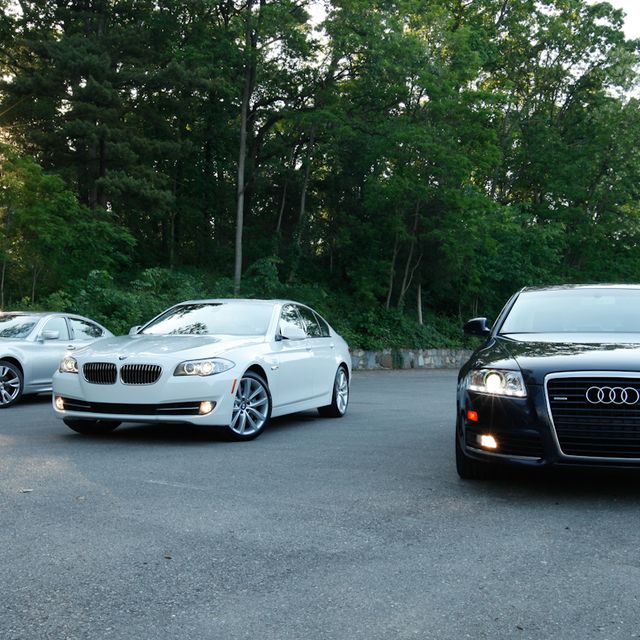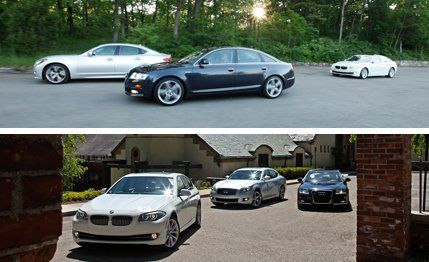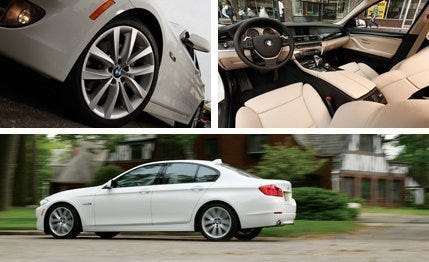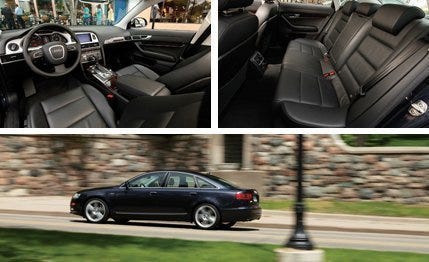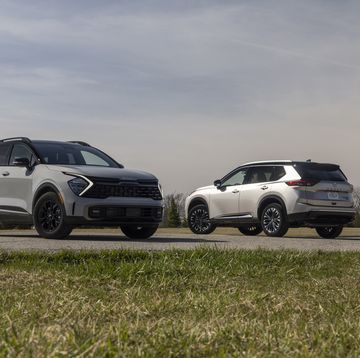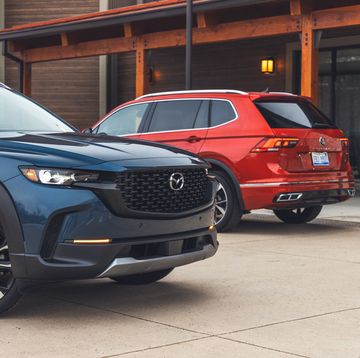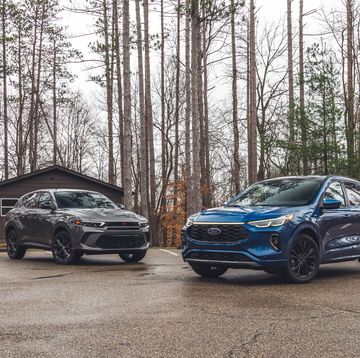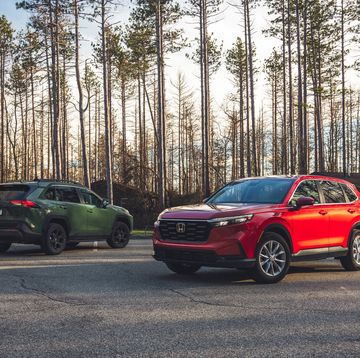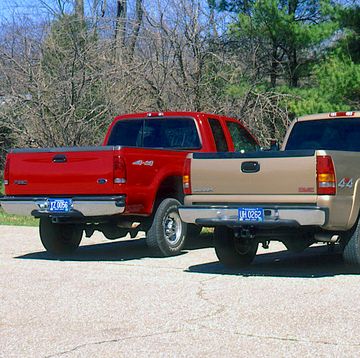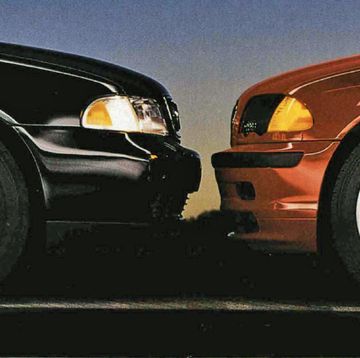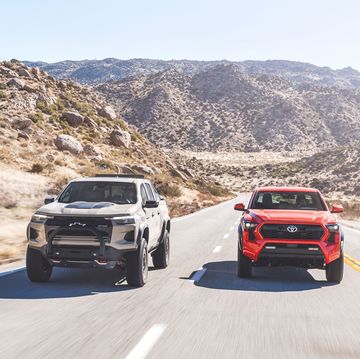At the outbreak of World War I, David Lloyd George—British statesman, prime minister, and all-around champion of the underdog—was annoyed by the then-popular refrain, “The war that will end war.” Instead, he said, “This war, like the next war, is a war to end war.”
And so go the wars among the $50,000 luxo-sports sedans, a burgeoning and combative niche whose inhabitants seemingly engage in almost monthly one-upmanship. In fact, it was just last September that we ran our “Five at Fifty” comparo, in which a quintet of 50-grand execuliners duked it out. In that battle, an Audi A6 3.0T Quattro prevailed, followed not far behind by a BMW 535i and an Infiniti M45. Since then, the would-be Audi slayers have comprehensively renovated their products, so another war—this one surely a war to end war—seemed justified.
Naturally, the Audi returned, as champions will, shod with 19-inch Michelin Pilot Sport PS2s rather than the previous Pirelli P Zero Rossos.
BMW’s sixth-gen 5-series, now based on vehicle architecture shared with the 7-series, has been as thoroughly updated as the auto-dial directory in Tiger Woods’s cell phone. Several key dimensions are up, notably wheelbase (3.2 inches), length (2.0 inches), and rear track (1.9 inches). The inline-six has lost one turbo in favor of a single twin-scroll unit along with BMW’s Valvetronic throttleless intake system, and fuel is still injected directly into each cylinder. Power and torque remain static, but the lone-turbo layout has allowed BMW to revert to a single exhaust stream wending its way through a single catalytic converter.
Next, the Bavarians have, for the first time in 5-series history, opted for steering with electric power assist—a major shake-up, as we shall see. More aluminum has been deployed, including the doors (also a first), along with the hood and the front fenders, whose skins readily flex with the push of a finger. (Odd, then, that our 2011 test car weighed 212 pounds more than our previous manual-transmission 535i.) The front suspension’s strut has been replaced with a multilink arrangement, and the rear suspension now sports a fifth link. The transmission spins not six gears but eight, which seems like an awful lot. A clutched alternator charges the battery primarily while the car is decelerating in order to waste as little energy as possible. And, finally, the grille’s insignia kidneys jut forward more arrogantly, as if to taunt those poor souls in need of a transplant.
The Infiniti, too, has undergone a major makeover, with numerous swaths of its handsome new bodywork looking downright Jaguarish. With a Cd of only 0.27, it’s slippery, too. Width is up 1.5 inches, length is increased by 0.6 inch, and the rear-drive M37 offers a wider track. Underhood, you’ll now find the same V-6 used in the Nissan 370Z, producing five more ponies than were available from the former V-8–powered M45.
All of that fiddling, one would suppose, should be sufficient to dethrone the aging Audi, or at least scare it. Let’s find out.
A BMW finishes third in a three-car comparo? For those of you who monthly accuse us of porcine gorging at BMW’s fiscal trough, will this persuade you otherwise? Didn’t think so.
What, exactly, befell the new 535i? Steering feel. Rather, lack of steering feel. The new electric power assist has not only rendered the steering uncommunicative—particularly on-center—but, for some reason, it has also become heavier. When you can’t determine road textures and slip angles and how hard those 19-inch Goodyear run-flats are working, you lose confidence if the roads are damp and as kinked as week-old spaghetti.
And when you lose confidence, the poison seeps into other crevices. Notice, for instance, that the 535i demonstrated terrific skidpad grip—an objective rating. Then, in the hills, its handling earned the lowest score—a subjective rating. That, in turn, infected the fun-to-drive ranking, where the BMW tanked because it’s simply no bowl of cherries predicting real-world lateral stick when the steering coughs up so few clues. Guess wrong and you’ll seriously rearrange the C-pillar’s signature “Hofmeister kink.”
This is the sort of faux pas—like the original X3’s granitic ride—that BMW corrects pronto, so we have hope. And, in truth, the mute steering did offer the best interstate tracking. Combine that with the quietest cabin at a 70-mph cruise and you’ve got a stellar cross-country vacationeer. Speaking of treks, how come a nav system isn’t standard in a car in this class?
Otherwise, there was much here to admire. The brake pedal proved a paradigm of linearity and predictability, scoring a perfect 10. The tractable single-turbo inline-six evinced no lag and was as vibrationless and silky as any of BMW’s reciprocating devices. (Funny that the engine cover is emblazoned with the words “Twin Power Turbo.”) And the 535i was quickest to 60 mph and in its 50-to-70-mph passing potential.
It’s worth remembering that the 5- and 7-series now share enough hard pieces that they’re cousins, maybe kissing cousins. We mention it because the 535i felt larger, more solid, more dynamically massive than its colleagues in this test, as if BMW were withdrawing some of the “sport” half of the equation in favor of full execuliner status. If that marketing scheme fails, well, the Bavarians can always fall back on cachet. As our Tony Swan put it: “If impressing my neighbors is the key objective, the 535i wins.
We have historically embraced naturally aspirated engines over the force-fed lot. And on paper—and in the Nissan 370Z—this one looks like a middleweight champ, boasting a 30-hp edge over its adversaries. Those bonus ponies are earned by dint of an 11.0:1 compression ratio and voluminous revs. Peak power arrives at 7000 rpm versus the BMW’s 5800 and the Audi’s 5100.
What we’re saying is that this V-6, like a wool mill, requires major spinning before it delivers the goods. Notice that the Infiniti’s accel figures are all pretty equal to its competitors’ until triple-digit velocities are obtained. Notice, too, that its 30-to-50 and 50-to-70-mph passing abilities were the least impressive. In the hills, the M37 never felt quicker than the Audi, and with the pistons flailing so maniacally, it returned the poorest observed fuel economy. It’s lucky that all M37s come standard with active noise control. Our test car was the quietest at idle and at wide-open throttle, and the high-rpm coarseness that typifies the 370Z’s V-6 here went blessedly unnoticed.
Our Infiniti was fitted with the $3650 Sport package, including four-wheel steering. That might explain the steering’s abruptness just off-center, a trait that required some acclimatization. That sudden quickness sometimes engendered a ragged path—turn in, too much, back off, too much, turn in again.
Our car was also fitted with R-Spec high-friction brake pads ($370). We can’t swear they were responsible, but the pedal would be linear for half an inch, then take a bulldog bite, another behavior requiring a willing-to-learn driver.
Otherwise, the M37 was a stallion around our southern-Ohio Hocking Hills test route, making the most of its solid platform and its impeccable roll control, which kept it planted under almost all conditions. And when we flicked the magnesium paddles for downshifts, the automatic rev-matching system made us feel like heroes. Some of that cornering acumen, not surprisingly, came at the expense of ride, possibly the upshot of the sport suspension’s double-piston shocks. It was never harsh. Just a little nervous.
In the end, most of the Infiniti’s eccentricities were offset by compound curves—all of those swollen, bulging, rolling body panels and a swoopy cabin with twin leather hoods over the IP, handsome splashes of Japanese ash, and elegantly stitched pleated leather.
Too bad we couldn’t mute the XM NavWeather lady, whose synthesized voice repeatedly warned, “Severe flooding, 10 miles.” If the ark was out there, Noah kept it beached.
And, so, the Audi again sprays the Moët, a shocker given its status as a senior citizen. The current body style emerged in 2004 (as a 2005 model) and was mildly updated to its current robust mien in ’09. That’s when the Roots-type supercharger appeared, which transformed this car’s soul.
The blown engine produces the most torque in this group, and it is available from 2500 rpm to 5100 rpm. Although all three cars turned nearly identical quarter-mile ETs and speeds, the A6’s power is the quickest to manifest, as witnessed in its winning top-gear dash from 30 to 50 mph. Mat the accelerator exiting a turn, and the A6 leaps as if cattle-prodded, hooking up instantly and securely. Some of that grip can be attributed to the all-wheel drive and some to the famously sticky Pilot Sport PS2s, the latter included in the $1500 Sport pack. Which is fine by us because the A6 logged the greatest skidpad grip, the highest lane-change speed, and the shortest braking distance.
The Audi always felt as if it were conceived in Ohio’s “Hockingheim ring,” earning A+ grades for handling and steering. The steering, in particular, offered every trait that the BMW’s did not: light, linear, always talking in clear but dulcet tones about road textures and available grip, without a hint of kickback.
The logbook entries could have been plagiarized from a Hallmark Mother’s Day card: “Lovably light, agile on its feet, intuitive.” “Accuracy and predictability are virtues that are appreciated.” “Superb path control, easy to operate at its limits.” And all three test drivers routinely used the word “forgiving” to describe the Audi’s nature on narrow, unknown roads where blind brows often preceded nasty hairpins.
The Audi evinced more body roll than its colleagues, but it never gave the impression that big weight shifts were afoot, and the upside was that its ride was as good as—actually, slightly better than—the BMW’s.
Our beefs were few. The A6 offers the least front interior volume and the least back-seat comfort, made worse by rear armrests too stubby to support elbows. And the cabin, with time, has become a somewhat dreary, dour domain, embellished only by a few real-wood accents that can’t overcome a vast swath of dull and miserly silver trim surrounding the gauges and the nav screen. “Put the Infiniti’s cabin in here!” demanded one editor. Moreover, the Audi’s paddle shifters are midgets, half the size they should be.
Still a winner in its class, the A6 should nonetheless benefit from a vigorous makeover for the 2012 model year, with sales to commence as early as next spring. Our advice to Ingolstadt: “Don’t screw it up.” Meanwhile, watch for another installment of “the war that will end war” in but a few months.
